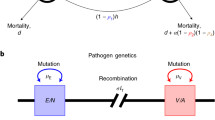Abstract
Soubeyrand and Plotkin question our contention that antitoxin vaccines may select for greater pathogen virulence, arguing that this has not been borne out in real-life cases of diphtheria and pertussis, in which the widespread use of antitoxin vaccines has led to a reduced incidence of severe disease. They explain this success in terms of direct effects by the toxin on transmission that are both beneficial and costly. They argue that antitoxin vaccines have relieved the pathogen of the cost of high virulence due to host mortality (as we do too), but that these vaccines also maintain the metabolic cost of producing the toxin, helping natural selection to weed out the toxin producers.
Similar content being viewed by others
Gandon et al. reply
In our model, we assume no such effects of toxin production — we envisage toxin production as an unavoidable, unhelpful side-effect of parasite replication, as seems to be the case in malaria. The apparent contradiction between our predictions and the observations cited by Soubeyrand and Plotkin is therefore due to differences in the life histories of different pathogens.
Our model can easily be extended to incorporate the costs and benefits of toxin production by modifying the pathogen's fitness function as follows:

where τ is the level of toxin production, r is the efficacy of the antitoxin vaccine, e-cτ is the cost function of toxin production, β represents parasite transmission as an increasing function of both toxin production and another component of disease-induced mortality, α, and δ is natural host mortality. Maximizing fitness yields the evolutionarily stable toxin production, τ*, shown in Fig. 1. When the cost of toxin production is zero (as is assumed in our original model), virulence increases with vaccine efficacy. When the cost of toxin production is high, however, it counteracts the toxin's benefit to transmission, in which case optimal toxin production decreases with vaccine efficacy.
Figure 1 also shows that whereas highly effective antitoxin vaccines select for lower toxin production, imperfect vaccines can select for higher toxin production, which supports our argument that the use of imperfect vaccines can have negative consequences. The examples provided by Soubeyrand and Plotkin emphasize the need to understand how virulence and transmission relate to pathogen fitness for each disease of interest. Virulence evolution can occur in response to vaccination and other increases in host defence, both in positive ways, as Soubeyrand and Plotkin argue has occurred for diptheria and pertussis, and in negative ways, as others have argued may be the case in Marek's disease1 and myxomatosis2.
References
Witter, R. L. Acta Vet. Hung. 45, 251–266 (1997).
Fenner, F. & Fantini, B. Biological Control of Vertebrate Pests: The History of Myxomatosis — an Experiment in Evolution (CABI, Wallingford, UK, 1999).
Author information
Authors and Affiliations
Corresponding author
Additional information
brief communications is intended to provide a forum for both brief, topical reports of general scientific interest and technical discussion of recently published material of particular interest to non-specialist readers. Priority will be given to contributions that have fewer than 500 words, 10 references and only one figure. Detailed guidelines are available on Nature's website (http://www.nature.com/nature) or on request from nature@nature.com
Rights and permissions
About this article
Cite this article
Gandon, S., Mackinnon, M., Nee, S. et al. Antitoxin vaccines and pathogen virulence. Nature 417, 610 (2002). https://doi.org/10.1038/417610a
Issue Date:
DOI: https://doi.org/10.1038/417610a
Comments
By submitting a comment you agree to abide by our Terms and Community Guidelines. If you find something abusive or that does not comply with our terms or guidelines please flag it as inappropriate.




